Carrying the proper fire starting implements is important for any camping trip, but what’s better to bring – a butane lighter, stormproof matches, or a ferrocerium rod?
Well, fire starting can be a contentious topic since, and depending on your situation, your survival can depend on it.
Each method of starting a fire is completely unique with its own benefits and drawbacks. But, in an emergency situation, what do you want to have in our pocket?
So, let’s discuss some fire basics and whether you should carry a lighter, matches or ferrocerium rod when camping.
Article Contents:
Fire Basics – It’s All About Heat
A fire requires three basics ingredients – oxygen, fuel, and heat. Together, they make the fire triangle and missing one of these key elements will result in a lack of a fire.
- The oxygen is present in the atmosphere
- Fuel can be any material that is combustible or can catch a flame and sustain that energy such as wood, paper, grass or even dung
- Heat is the final part of generating a fire and it’s usually the hardest aspect to create
Most primitive approaches for generating heat rely on friction which are mostly the hand drill or bow drill methods. Primitive friction techniques are extremely useful to know in survival situations. However, they are very labor intensive.
Thankfully, there are more “evolved” and modern methods of generating heat.
Evolution of Heat Sources
As humans have evolved to rely more and more on fire, we’ve also created more robust, reliable, and advanced techniques for generating the heat portion of the fire triangle.
Advancements in chemistry, mechanics, and metallurgy have resulted in three common heat generating methods – matches, lighters, and ferrocerium rods.
Each of these three fire starting methods have drastically lower energy input requirements, are highly reliable, and can efficiently provide the necessary heat to start a fire when used correctly.
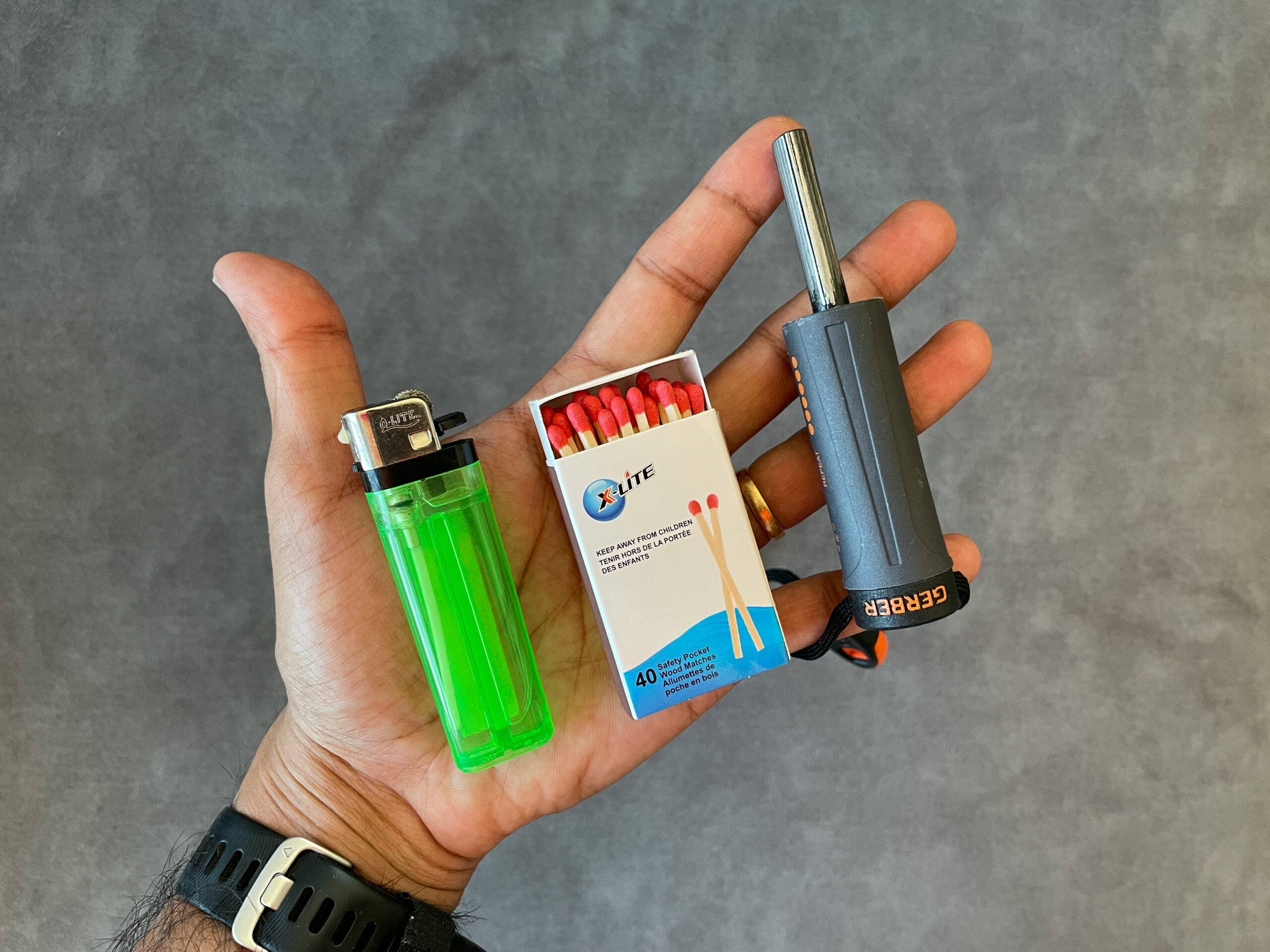
What Should You Carry When Camping?
The decision to carry either matches, a lighter, or a ferro rod boils down to a two key aspects – efficiency and reliability.
Efficiency and reliability means that no matter the outside conditions, your energy level, or any time limitations, the fire starting tool will work.
My Recommendation
Personally, I tend to always carry a small butane BIC lighter as my primary means of producing fire. It’s extremely reliable, portable, robust, and low cost.
- A butane lighter gives you the lots of flexibility when it comes to fire starting
- You can instantly create a flame, modify your technique, or stop it if conditions change
You can also produce a flame very consistently and reliably in pretty much all weather conditions and environments.
The other massive factor for me is availability. You can walk into any gas station or grocery store and pic up a BIC butane lighter for a very low cost.
Redundancy
When backcountry camping, I also carry waterproof matches as well as a small ferrocerium rod as backup secondary fire starting tools along with my primary butane lighter.
Yes, I tend to over-prepare but I’d rather be safe than sorry.
That’s because in remote situations, such as portage camping or alpine climbing, having multiple means of fire starting will ensure you can cook food, build a fire to stay warm, or signal for help if required.
Starting a Fire
Starting a fire reliability in windy, wet, or cold conditions is a true test of both your abilities and the fire starters. Ideally, you want to be the limiting factor, not the fire starter.
- A butane lighter gives you multiple instant attempts at initiating a fire.
- You can reset your position or readjust anything without having limited time.
With a match, you need to be absolutely certain of your technique since once you strike it there’s a limited amount of time before the flame goes out. Also, you need to ensure that the match is protected from random wind gusts and rainwater, however this isn’t a problem if you have “stormproof” matches.
Likewise, with a ferro rod, a larger amount of care and planning is required for fire starting. You need to ensure your tinder is positioned correctly and ready to accept sparks.
Starting a Camp Stove
Some camp stoves do not include a built-in fire starter. Usually these are liquid fuel camp stoves. In those cases, an outside flame or spark is needed for the stove to work.
All three fire starting methods here are on the same level. However, I like to use a ferro rod to light my backpacking Coleman liquid fuel stove. The ferro rod allows me to get some distance from the initial flame which can be quick large.

Weather Conditions
Cold temperatures, rain, and wind gusts can wreck havoc on your ability to start a fire reliably. In extreme conditions, you need to protect that initial heat source or flame.
- Regular matches need to be kept dry and shielded from wind which can easily blow out a flame
- Stormproof matches can burn reliably regardless of the weather conditions
As mentioned in my butane camp stove article, temperatures below 0°C (32°F) render a butane lighter useless.
- Liquid butane stops converting into gaseous butane at low temperatures
- The solution is to keep the butane lighter close to your body to keep it warm before use
Ferrocerium rods work in pretty much all environments. Whether it is +40°C or -40°C, windy or wet, a ferro rod can produce hot sparks to start a fire.
Physical Limitations
Physical injuries, limited physical dexterity, or compromised fine motor skills can also dictate which fire starting method works best for you.
Imagine having your hands in mittens, or an injured hand. Which implement could you still get to work?
- Lighters require the use of fine motor skills and capable fingers for use
- Matches require less fine motor skills than lighters
A ferro rod requires the least amount of fine motor skills
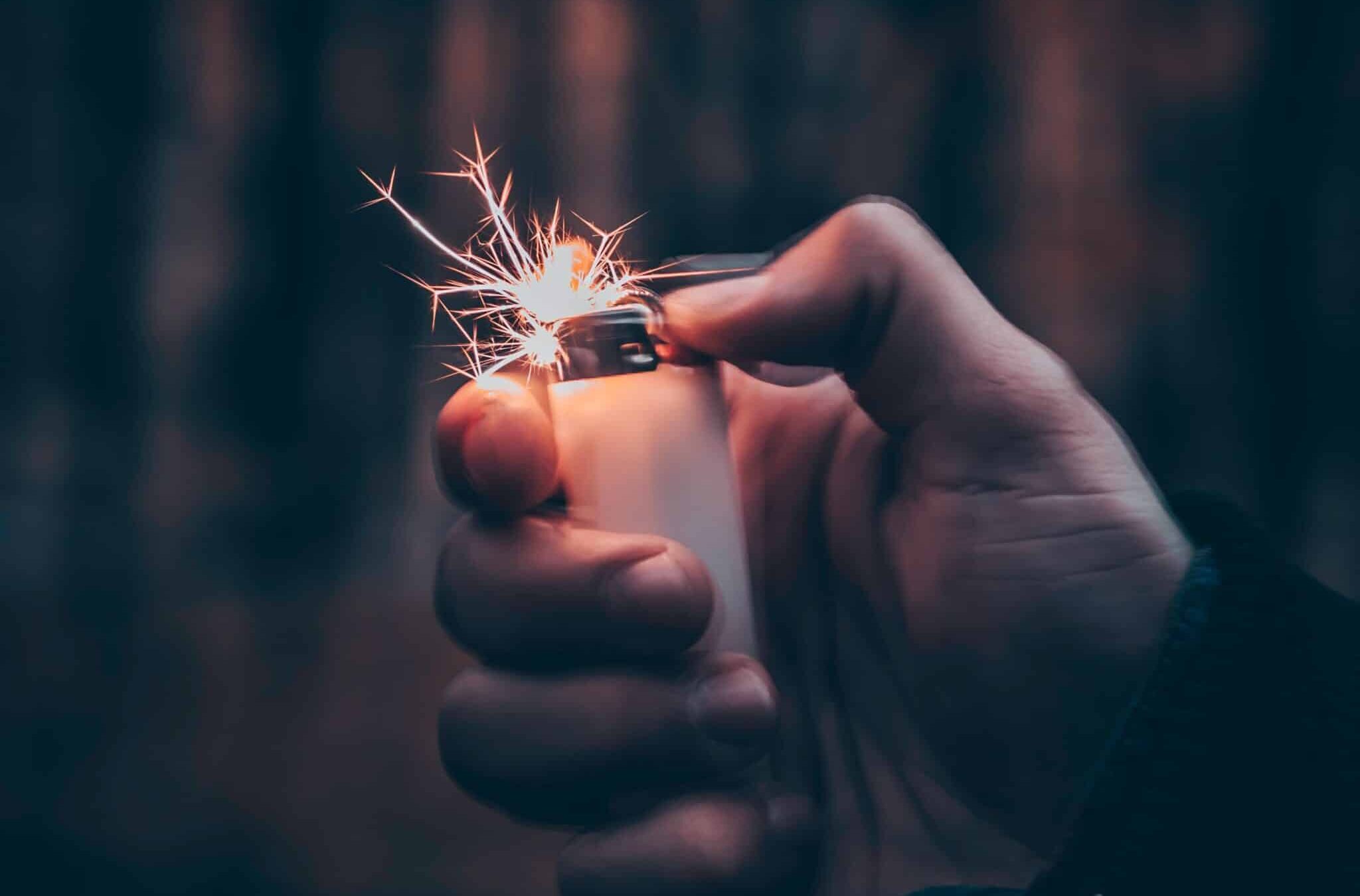
Butane Lighters
What is a Butane Lighter?
A butane lighter is small device that contains butane, a highly flammable liquefied gas, and a spark generating mechanism.
- Commonly used butane lighters are BIC or Zippo brand lighters
Butane lighters are popular because the flame and reaction products are very clean – colourless and odorless. They are also very easy to use, safe, reliable, and consistent unit to unit.
How Does a Butane Lighter Work?
A butane lighter works by releasing a small stream of gasified butane which comes into contact with sparks igniting the butane.
The sparks are created either by a steel roller contacting a piece of flint, or a by activating a mechanic device connected to a piezoelectric material which generates an electric arc.
Are Butane Lighters Reliable?
A huge reason why butane lighters are so popular is because they are incredibly reliable. The overall design and mechanics are simple.
Yes, there are moving parts that may break, but if kept moderately safe a butane lighter will last as long as it has fuel.
Butane lighters can be dropped from waist height and not break. They are very portable and can easily be stored in a backpack or pocket.
- The only thing you need to worry about is making sure nothing will depress the fuel valve which can release the butane when not in use
That’s why it’s best to keep it in a top backpack pouch or pant pocket without anything large or heavy.
Do Butane Lighters Work When Wet?
Butane lighters are great because they are built somewhat waterproof. No, you can’t go diving with one, however if it falls into a stream or gets rained on it can still work just fine.
The key is to let the steel roller and flint dry off.
- Shaking it free of any water droplets and leaving it in the sun helps to speed up the drying process.
And, before you know it, it’ll be good to go!
How Long Does a Butane Lighter Last?
A butane lighter will only last as long as it contains butane fuel. And how long the fuel lasts depends on how long it takes you to light each fire.
In some cases, it might only take you less than a second to transfer enough heat energy to a tinder pile. In other cases, it might take up 30 seconds to get a fire bundle started.
So, how long does the fuel last in a standard BIC lighter?
Well, the most common size BIC butane lighter is 3”. If it takes on average 5 seconds to light a fire, and in ideal temperature conditions, you should be able to get approximately 650 lights from a standard BIC butane lighter.
How Much Does a Butane Lighter Cost?
Even with inflation running rampant, BIC butane lighters are still relatively affordable. A 5-pack of standard 3” BIC butane lighters is $10 which works out to be $2 per lighter.
The great thing is you can easily find a BIC butane lighter at any local convenience store pretty much anywhere in the world.
I recommend getting a 3-pack of BIC EZ Reach Butane Lighters which is $11.
- They have an extended wand section which keeps your fingers further away from the flame and is beneficial for lighting camp stoves and campfires
- The trigger is also designed to prevent accidental depression and gas use
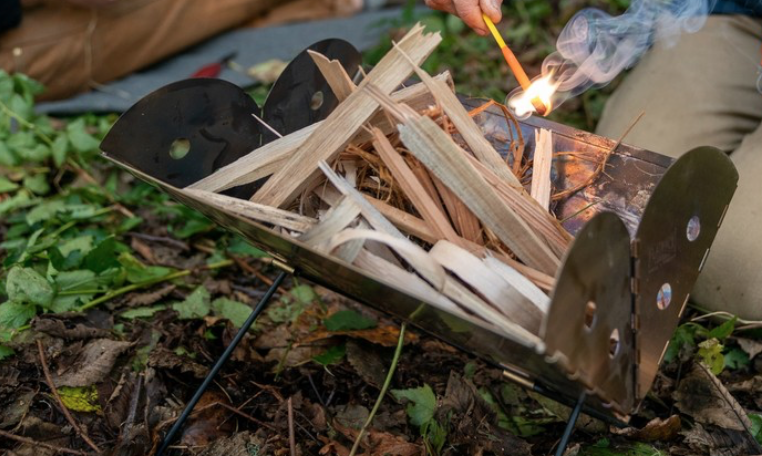
Stormproof Matches
What are Stormproof Matches?
Have you ever tried to light a match outside on a windy day? How hard was it to keep the flame protected before it blew out?
Well, that’s because traditional matches aren’t made for extreme conditions, not in the slightest. Wind gusts or moisture can snuff out a flame pretty easily.
From a design perspective, a traditional match has a very small chemical-coated head that, when ignited, transfers heat to a wooden matchstick.
- The flame from a traditional match only lasts about 7 to 10 seconds before it burns all the way through.
So, if you’re in a dire, emergency situation, traditional matches might end up letting you down.
But, there’s a better option out there… Stormproof matches!
Stormproof matches are designed with enhanced flame generation and flame sustaining properties. That means stormproof matches can ignite in any conditions, and stay lit for much longer (15 to 25 seconds depending on the type) which improves your ability for fire starting.
How Do Stormproof Matches Work?
Stormproof matches are regular matches on steroids. They contain much more chemically reactive components which helps to ensure it burns stronger and longer in any condition.
- Each stormproof match consists of three parts – the sulfur head, the chemically-coated potassium chlorate body, and wooden core
- The match case also incorporates a striking surface
These individual components combine to create a very robust fire starting implement.
- Stormproof matches are designed with a special chemical coating that is both waterproof and windproof.
- The coating contains potassium chlorate, a powerful oxidizing agent which reacts vigorously creating lot of heat
The head of a stormproof match contains sulfur. When you strike it against the striking surface on the match holder a reaction occurs between the sulphur head and the red phosphor coating on the striker.
This initial reaction ignites the potassium chlorate coating, which burns at a high enough temperature to create a flame and burn the match stick.
Do Stormproof Matches Work When Wet?
Stormproof matches work when wet because they are coated with potassium chlorate.
- The potassium chlorate reaction makes storm matches windproof, waterproof, and dirt-proof
You can even ignite a stormproof match and submerge the lit matchstick completely in water and then remove it is still able to burn!

How Much Do Stormproof Matches Cost?
Compared to traditional matches which cost about a penny per stick, stormproof matches are quite a bit more expensive.
The best stormproof matches are made by UCO. UCO sells a Stormproof Match Kit with 25 Matches and 3 Replaceable Strikers for $9. The kit includes a waterproof case to keep the matches dry and protected, and stores the replaceable striker paper. Each match has a burn time of 15 seconds.
Alternatively, you can also get a 25 pack of UCO Titan Stormproof Matches for $16. These matches have a 25 second burn time, and offer the same waterproof, windproof, and dirt-proof qualities.
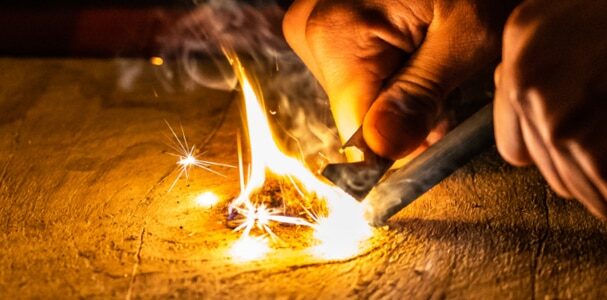
Ferrocerium Rods
What is a Ferrocerium Rod?
A ferrocerium rod, also known as a ferro rod or fire-steel, is a special alloy metal that when struck against with a harder material creates high temperature sparks (over 3000oC) that can be used to ignite flammable material.
How Does a Ferrocerium Rod Work?
Ferrocerium is a synthetic metal alloy made from mostly cerium (~42%) and iron (21%) [Reference]. It is classified as pyrophoric, which means it has a very low ignition temperature.
Ferrocerium is a very popular fire starting method because the mechanism by which heat is generated is very simple.
Rapidly scraping off small amounts of ferrocerium with a sharp hard material results in the ferrocerium material oxidizing in air. The air oxidation process is essentially a chemical reaction that auto-ignites the material, burning it at very high temperatures.
These high temperature sparks can be used in conjunction with highly flammable tinder to create a fire.
Do Ferro Rods Work When Wet?
Ferrocerium rods do not absorb or retain moisture so they can still work when wet. However, prolonged exposure to rain or moisture can lead to surface oxidation or rust.
Rust will not negatively impact a ferro rods ability to produce sparks. You’ll just need to scrape off the already oxidized layer to reveal the non-oxidized portion which will then rapidly oxidize and spark when you scrap it off.
How Long Does a Ferro Rod Last?
A high-quality ferrocerium rod can last between 6,000 to 20,000 strikes. The number of strikes depend on a variety of factors including:
- Alloy hardness (harder alloys last longer than softer alloys)
- Rod size (diameter and length influence total material available)
- User technique (light touch versus heavy pressure strikes removes different amounts of material)
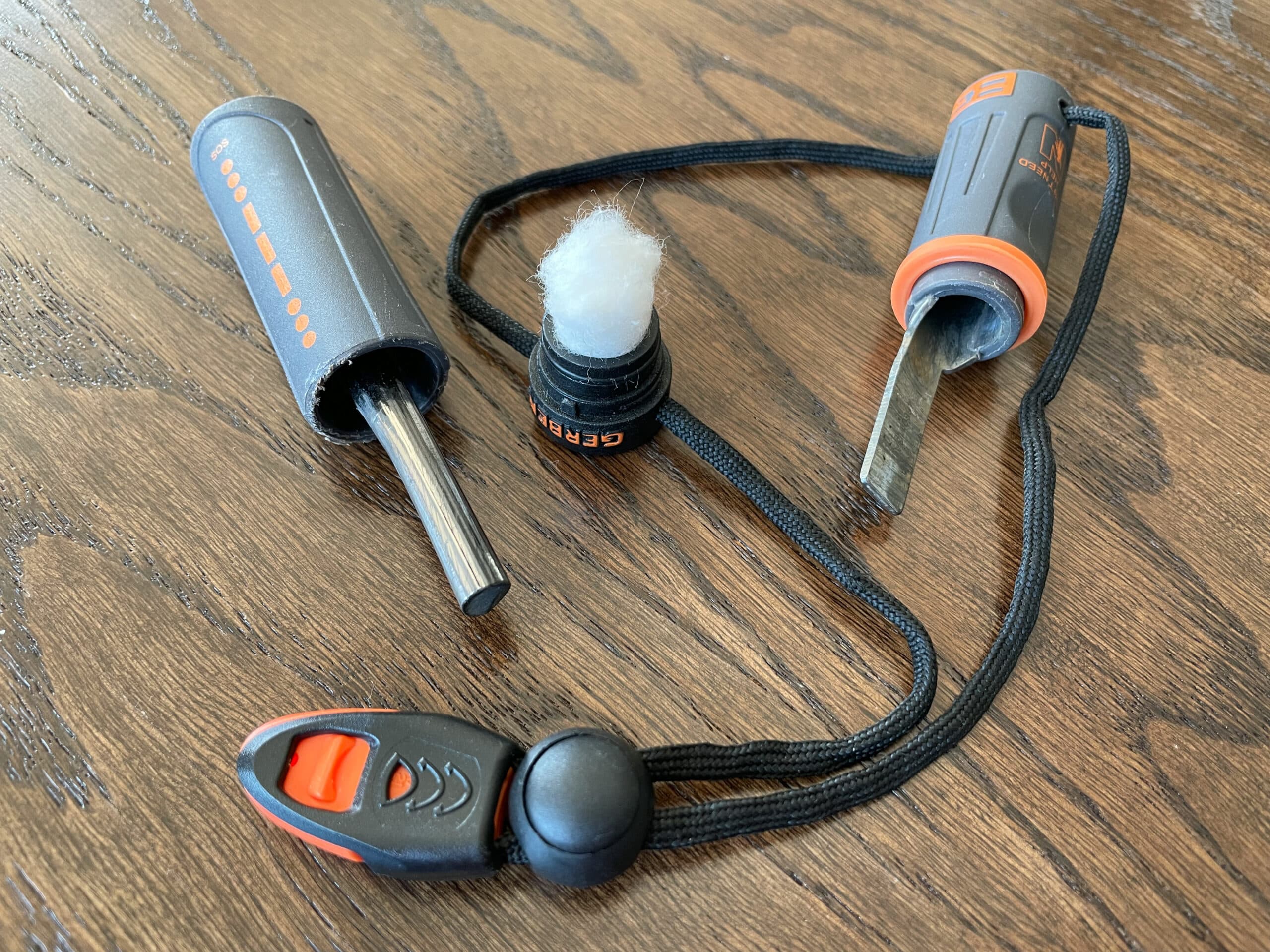
How Much Does a Ferro Rod Cost?
The cost of a ferrocerium rod depends on the diameter and length. A traditional 5/16” diameter ferro rod with a length of 3” costs between $10 to $25. Some ferrocerium rods include a ergonomic handle or a lanyard loop as well as a small straight-edge striker.
Personally, I carry a Gerber Survival Fire Starter tool. I like it because the ferrocerium rod is compact, and the handle includes a water resistant compartment to store tinder (cotton). There’s also a whistle included in the lanyard.
Most people will opt for a more traditional fire starter option like this überleben Zünden Ferrocerium Rod. It comes in three options however I recommend going with the ½” diameter rod. The wooden handle is a nice touch and the included striker doubles as a 6-function multi-tool.
This article contains affiliate links, which help support this blog at no cost to you!
